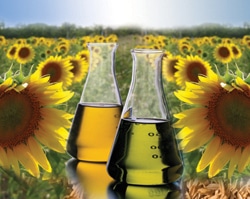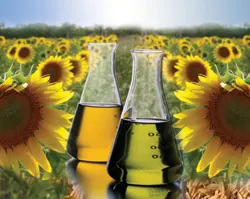
Ethanol Used As A Fuel
Ethanol the most widely used Biomass Fuel Type
![]() Biomass has been a major source of energy in the world since the beginning of time and has now developed into an interesting alternative energy source. Climate change and pollution around the world has lead to developments in biofuels and especially on the demand for ethanol used as a fuel for transportation.
Biomass has been a major source of energy in the world since the beginning of time and has now developed into an interesting alternative energy source. Climate change and pollution around the world has lead to developments in biofuels and especially on the demand for ethanol used as a fuel for transportation.
Biomass is the generalised term used to describe any kind of organic biological matter that can be converted into useful energy. Biomass is renewable energy produced by living things like plant and vegetable matter or by the waste that living creatures produce.
The potential of biomass as an energy source is enormous and the transformation of these common substances, which would otherwise end up as waste, into other forms of biofuels is an exciting area that has a great deal of potential. Basically any fuel created from biomass can be called a “biofuel”, and today biofuels are the most widely used biomass fuel type with ethanol used as a fuel becoming a major source of green transportation fuel in many countries.

So how is biomass used as a fuel. Biomass is organic matter as it comes from living things, just like fossil fuels are derived from coal, oil, or natural gas, which themselves are formed in the Earth from dead plant and/or animal remains.
Biomass can be used to produce different forms of energy such as heat, electricity and transport fuels especially in the production of liquid fuels such as ethanol and biodiesel.
The most widely used biomass fuel type and a very exciting alternative energy area is biofuel, and especially second generation biofuels. There are many different types of biofuel, but liquid biofuel is any kind of liquid derived from biomass that can be used as fuel.
The following two main types of biofuel are: Biodiesel, which is diesel fuel made of vegetable oils instead of petroleum. Ethanol and other alcohol fuels, which are made from corn, grain, and other plant matter and can be mixed with or substituted for gasoline.
Ethanol Used As A Fuel
Biofuel is an exciting prospect because it enables farmers to turn excess crops into fuel. The biofuel that is the main focus of research is ethanol. Ethanol, ( C2H5OH ) which is also known as ethyl alcohol and is the same kind of alcohol found in alcoholic beverages, is an alcohol-based form of biofuel that can be produced from renewable sources such as corn, oil seeds, potatoes, starch crops and sugar cane, etc. that have been broken down into a variety of simple sugars. Ethanol-based bio fuels are extracted from corn.
Ethanol-based bio fuel is now the main alternative to automotive fossil fuels as it can be used to run cars and to power engines, either by itself or mixed with gasoline or other fuels. Ethanol used as a fuel is the most common of the bio-alcohols that can be used to power engines and there is an increasing interest in the use of ethanol to replace or augment gasoline as a significant source of automotive fuel. Gasoline combined with ethanol results in a fuel which is affectionately called Gasohol.
Ethanol is classified as an “oxygenate”, meaning it increases the oxygen content of the fuel that it is blended with acting more like an octane booster. When ethanol is used as a fuel to power motor vehicles instead of gasoline, the engine must be specially fitted to run on the new gasohol mixture, as an ethanol fuelled car engine uses higher compression ratios.
Also ethanol burns more cleanly than gasoline producing fewer air born pollutants making ethanol fuelled engines last longer and run smoother, as what comes out of the tail pipe is just water vapour and reduced CO2 emissions.
Today, major car companies are building ethanol-powered cars, and gas stations are creating ethanol fuelling stations, and the use of ethanol as a fuel to power our vehicles is definitely on the rise. Ethanol fuelled vehicles offer increased power output and better fuel economy by up to 20% higher mileage than vehicles that run on gasoline alone.
Ethanol is a viable, home-grown energy alternative to fossil fuel with blends of gasoline and alcohol being identified by abbreviations that combine the letter “E” (for ethanol) with a number indicating the percentage of ethanol in the blend. For example the most popular are: E10 containing 10 percent ethanol and 90 percent gasoline, E5 contains 5 percent ethanol and 95 percent gasoline, and the much richer in ethanol mixture E85 contains 85 percent ethanol and only 15 percent gasoline.

One of the advantages of Ethanol is that it biodegradable because it is made from natural elements, so if you accidentally spill it, it will not be harmful to you or the environment.
The disadvantage is that ethanol production requires large numbers of crops to produce the amount of ethanol fuel required. The most important consequence of biofuel and biomass power production is the use of agricultural land, which is a scarce resource in the planet.
The actual ratio of crops to ethanol is around 100:1 or something like that. Therefore, farmers and producers would need more land to plant biofuel energy crops and less land for food crops. The biomass produced from living things like the waste energy from living creatures can also be used to produce biofuels.
With all of these said and done, we can’t rule out the fact that ethanol fuel is still one of the best possible options in the search for alternative fuel sources. There are many uses of ethanol as a fuel as it is a very valuable alternative to fossil fuels, it simply needs to be better regulated. By properly balancing our corn resources between food and fuel needs, we will have a long term and sustainable fossil fuel alternative.
Biofuel and especially the uses of ethanol as a fuel is a high potential area as it will have a real effect in reducing our dependence upon foreign oil for gasoline consumption, which is a key element in our addiction to oil, and as global demand for oil grows the use of ethanol and biodiesel will grow as well.
For more information about Ethanol and how ethanol can be used as fuel, or to obtain more information about the various types of biofuels available, or to explore the advantages and disadvantages of some of the most widely used biomass fuel types, then Click Here to order your copy from Amazon today about the many uses of ethanol as a fuel.










Hi guys,
I know that fruit/veg/plants are rich in carbohydrate and fibre and they are made of cellulose which is essentially a glucose polymer. I was looking for a way to unleach these glucose monomers to fuel the reaction to make ethanol. My question is, what would be the cheapest method of hydrolysing these starches/carbs?
I could either do it enzymatically or I could use acid hydrolysis. If I was to use the latter, which would be the cheapest acid to use? ie. hydrochloric, sulphuric, vinegar. What sort of pH should I be hydrolysing at?
I also wanted to know if i could use waste paper and cardboard, would this be possible? i would assume so seeing as they are made from trees (cellulose).
My idea was to shove my fruit/plants/paper into a food processor or blender and then soak the mush in an acid bath. After the carbs have been hydrolysed what would be the cheapest alkaline substance to neutralise the acid so that the glucose can be converted into ethanol by yeast?
Any ideas will be much appreciated
Thanks in advance,
Mubs
From my reading, and other folks testing, it appears that it is BARELY cost effective to make ethanol from even a source that is a direct sugar, if processing from a starch the extra cost of the enzyme and added heating steps only make it practical with some sort of cost substities. If using celulose as the feedstock it is basically a huge looser, there are millions of dollars being granted to universities trying to develop some enzyme procees but I have not read of any breakthroughs yet. Cellulose is at least a 5-6 primary step process – Convert the cellulose to a shorter chained starch, Use enzyme to turn the starch into even shorter chained sugar that IS NOT fermentable, then more enzyme to convert these into even shorter chained fermentable sugars, then ferment using yeast, then distill.
You can do the acid process but it only converts a few percent of the cellulose into starch that you then have to correct the PH of and reprocess using enzymes, then more enzymes to convert to the correct sugar, then more heat for the distillation. NOT Practical, even processing corn my calculations showed it would cost around $2.50 per gallon of ethanol to produce, this was with $2.50/bushel corn and did not take the cost of the fuel for heating into account. Good luck.